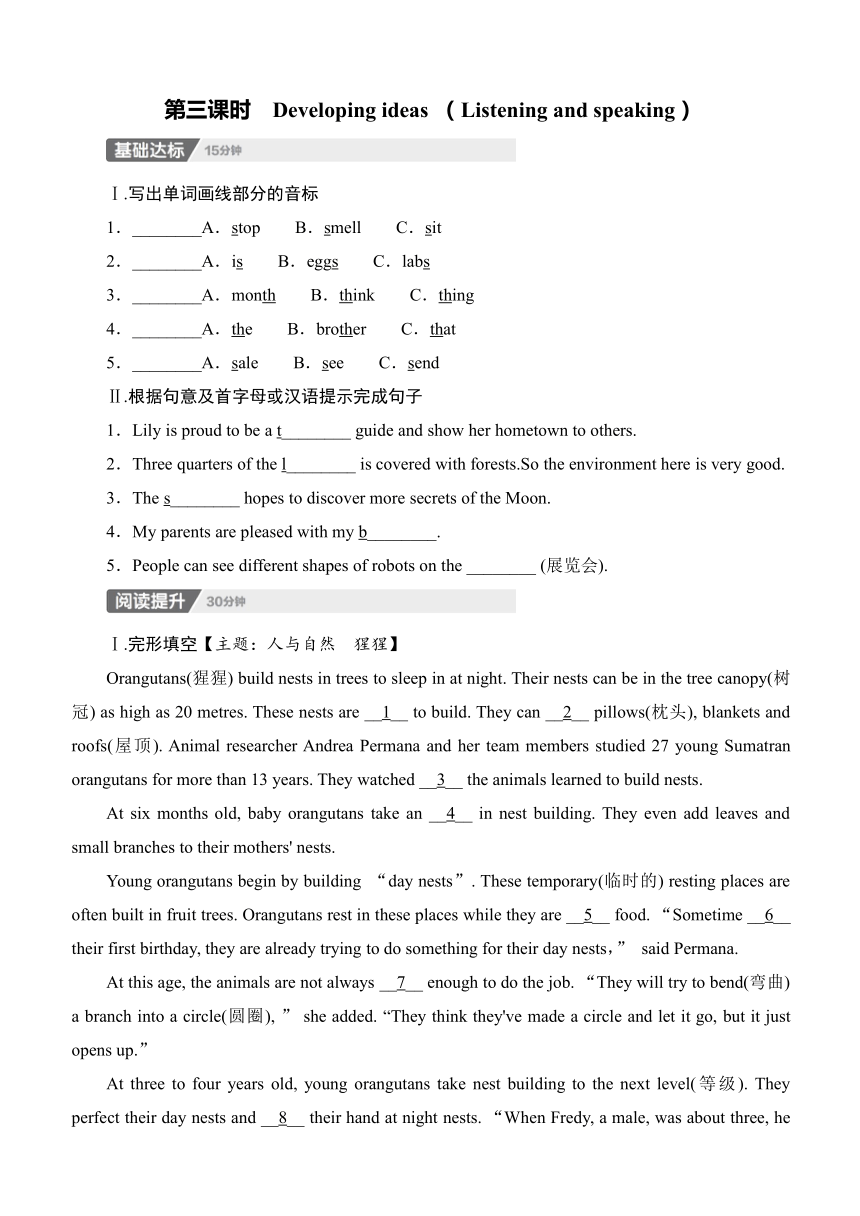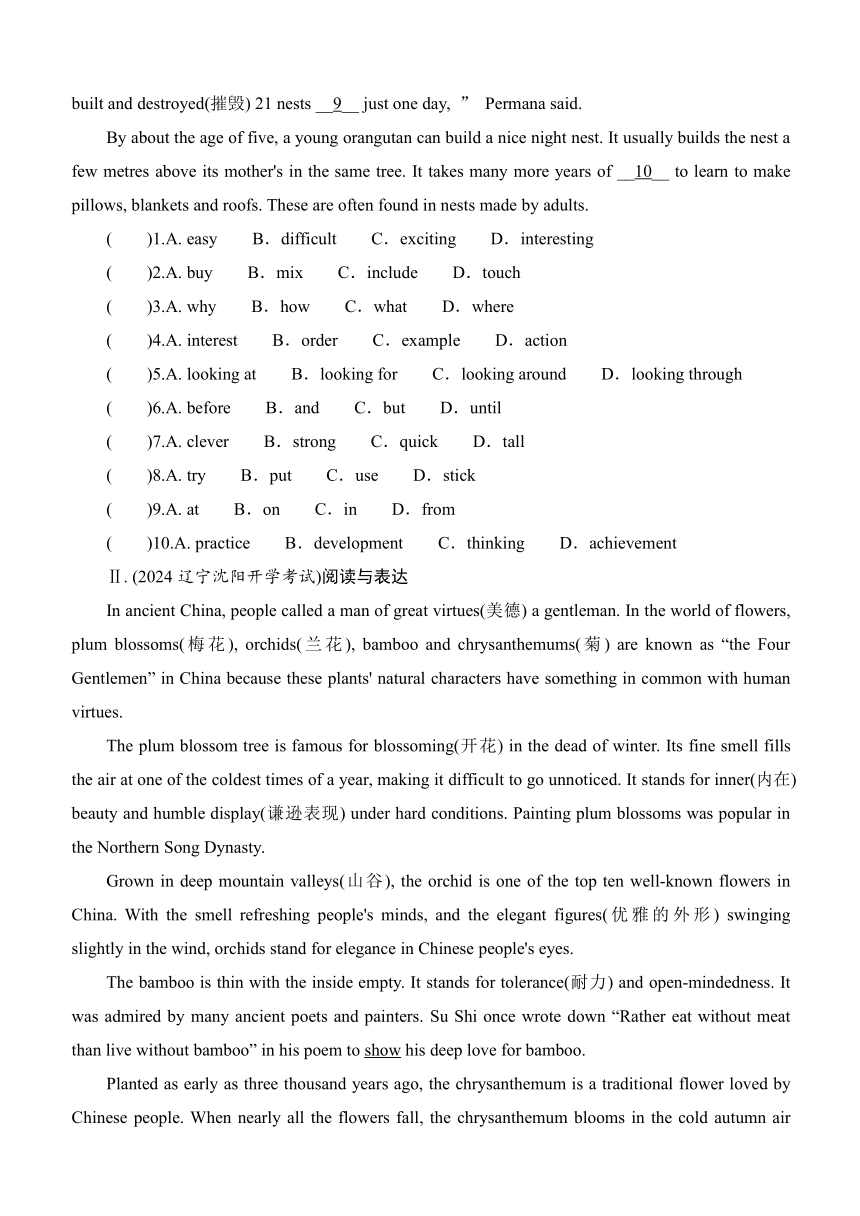Unit 5 Amazing nature 第三课时Developing ideas 练习(含答案) 外研版(2024)七年级下册
文档属性
| 名称 | Unit 5 Amazing nature 第三课时Developing ideas 练习(含答案) 外研版(2024)七年级下册 |  | |
| 格式 | docx | ||
| 文件大小 | 46.1KB | ||
| 资源类型 | 教案 | ||
| 版本资源 | 外研版 | ||
| 科目 | 英语 | ||
| 更新时间 | 2025-02-20 22:09:24 | ||
图片预览


文档简介
第三课时 Developing ideas (Listening and speaking)
Ⅰ.写出单词画线部分的音标
1.________A.stop B.smell C.sit
2.________A.is B.eggs C.labs
3.________A.month B.think C.thing
4.________A.the B.brother C.that
5.________A.sale B.see C.send
Ⅱ.根据句意及首字母或汉语提示完成句子
1.Lily is proud to be a t________ guide and show her hometown to others.
2.Three quarters of the l________ is covered with forests.So the environment here is very good.
3.The s________ hopes to discover more secrets of the Moon.
4.My parents are pleased with my b________.
5.People can see different shapes of robots on the ________ (展览会).
Ⅰ.完形填空【主题:人与自然 猩猩】
Orangutans(猩猩) build nests in trees to sleep in at night. Their nests can be in the tree canopy(树冠) as high as 20 metres. These nests are __1__ to build. They can __2__ pillows(枕头), blankets and roofs(屋顶). Animal researcher Andrea Permana and her team members studied 27 young Sumatran orangutans for more than 13 years. They watched __3__ the animals learned to build nests.
At six months old, baby orangutans take an __4__ in nest building. They even add leaves and small branches to their mothers' nests.
Young orangutans begin by building “day nests”. These temporary(临时的) resting places are often built in fruit trees. Orangutans rest in these places while they are __5__ food. “Sometime __6__ their first birthday, they are already trying to do something for their day nests,” said Permana.
At this age, the animals are not always __7__ enough to do the job. “They will try to bend(弯曲) a branch into a circle(圆圈), ” she added. “They think they've made a circle and let it go, but it just opens up.”
At three to four years old, young orangutans take nest building to the next level(等级). They perfect their day nests and __8__ their hand at night nests. “When Fredy, a male, was about three, he built and destroyed(摧毁) 21 nests __9__ just one day, ” Permana said.
By about the age of five, a young orangutan can build a nice night nest. It usually builds the nest a few metres above its mother's in the same tree. It takes many more years of __10__ to learn to make pillows, blankets and roofs. These are often found in nests made by adults.
( )1.A. easy B.difficult C.exciting D.interesting
( )2.A. buy B.mix C.include D.touch
( )3.A. why B.how C.what D.where
( )4.A. interest B.order C.example D.action
( )5.A. looking at B.looking for C.looking around D.looking through
( )6.A. before B.and C.but D.until
( )7.A. clever B.strong C.quick D.tall
( )8.A. try B.put C.use D.stick
( )9.A. at B.on C.in D.from
( )10.A. practice B.development C.thinking D.achievement
Ⅱ. (2024辽宁沈阳开学考试)阅读与表达
In ancient China, people called a man of great virtues(美德) a gentleman. In the world of flowers, plum blossoms(梅花), orchids(兰花), bamboo and chrysanthemums(菊) are known as “the Four Gentlemen” in China because these plants' natural characters have something in common with human virtues.
The plum blossom tree is famous for blossoming(开花) in the dead of winter. Its fine smell fills the air at one of the coldest times of a year, making it difficult to go unnoticed. It stands for inner(内在) beauty and humble display(谦逊表现) under hard conditions. Painting plum blossoms was popular in the Northern Song Dynasty.
Grown in deep mountain valleys(山谷), the orchid is one of the top ten well-known flowers in China. With the smell refreshing people's minds, and the elegant figures(优雅的外形) swinging slightly in the wind, orchids stand for elegance in Chinese people's eyes.
The bamboo is thin with the inside empty. It stands for tolerance(耐力) and open-mindedness. It was admired by many ancient poets and painters. Su Shi once wrote down “Rather eat without meat than live without bamboo” in his poem to show his deep love for bamboo.
Planted as early as three thousand years ago, the chrysanthemum is a traditional flower loved by Chinese people. When nearly all the flowers fall, the chrysanthemum blooms in the cold autumn air and foretells(预示) the coming of winter. It stands for the virtue to withstand(经得起) all difficulties.
1.Why are these plants called “the Four Gentlemen” in China
________________________________________________________________________
2.What part of speech(词性) is the underlined word “show” in Paragraph 4 A noun or a verb
________________________________________________________________________
3.Which season will come when the chrysanthemum blooms
________________________________________________________________________
4.Write down one of your favourite plants and explain why.(Write 30 words or more.)
________________________________________________________________________
【详解答案】
基础达标
Ⅰ.1./s/ 2./z/ 3./θ/ 4./ /
5./s/
Ⅱ.1.tour 2.land 3.scientist
4.behaviour 5.exhibition
阅读提升
Ⅰ.【语篇解读】本文主要讲述了猩猩从幼时到长大后的筑巢情况。
1.B 解析:句意:这些巢穴建造起来很难。easy“简单的”;difficult“困难的”;exciting“令人兴奋的”;interesting“有趣的”。根据“Their nests can be in the tree canopy(树冠) as high as 20 metres.”及下文内容可知,巢穴高度很高,建造起来困难。故选B。
2.C 解析:句意:它们可以包含枕头、毯子和屋顶。buy“买”;mix“混合”;include“包括”;touch“触摸”。根据“pillows(枕头), blankets and roofs(屋顶)”可知,巢穴里面包括这些物品。故选C。
3.B 解析:句意:他们观察这些动物如何学会筑巢。why“为什么”;how“如何”;what“什么”;where“哪里”。根据“They watched...the animals learned to build nests.”及下文内容可知,是观察动物们如何学习筑巢。故选B。
4.A 解析:句意:6个月大的时候,猩猩幼崽对筑巢感兴趣。interest“兴趣”;order“命令”;example“例子”;action“行动”。根据“They even add leaves and small branches to their mothers' nests.”可知,猩猩幼崽自小就对筑巢有兴趣。故选A。
5.B 解析:句意:猩猩在找食物的时候就会在这些地方休息。looking at“看着”;looking for“寻找”;looking around“环顾”;looking through“浏览”。根据“Orangutans rest in these places while they are...food.”可知,是在寻找食物的时候。故选B。
6.A 解析:句意:Permana说:“在它们第一次生日之前的某个时候,它们已经在为它们的日间巢穴做点什么了。”before“在……之前”;and“和”;but“但是”;until“直到”。根据“they are already trying to do something for their day nests”以及语境可知,是在生日之前,猩猩幼崽早已经开始建造巢穴了。故选A。
7.B 解析:句意:在这个年龄段,这些动物并不总是强壮到足以完成这项工作。clever“聪明的”;strong“强壮的”;quick“快速的”;tall“高的”。根据下文可知,小猩猩没办法把树枝折好,所以应是不够强壮。故选B。
8.A 解析:句意:它们完善了白天的巢穴,并尝试晚上的巢穴。try“尝试”;put“放”;use“使用”;stick“粘住”。根据“At three to four years old, young orangutans take nest building to the next level(等级).”可知,长大了的猩猩能力增强,可以做好白天的巢穴,所以是开始尝试晚上的巢穴。故选A。
9.C 解析:句意:Permana说:“当雄性Fredy大约三岁时,它仅在一天内建造并摧毁了21个巢穴。”at“在”;on“在……上面”;in“在(某段时间)内”;from“来自”。根据“he built and...just one day”可知,是在一天之内。故选C。
10.A 解析:句意:需要花更多年的实践来学习制作枕头、毯子和屋顶。practice“实践”;development“发展”;thinking“思考”;achievement“成就”。根据“It takes many more years...to learn to make pillows, blankets and roofs.”可知,要学会这些需要更多实践。故选A。
Ⅱ.【语篇解读】本文主要介绍了梅花、兰花、竹子和菊花在中国被称为“四君子”的原因以及每一种花与人类美德之间的共同之处。
1.Because these plants' natural characters have something in common with human virtues.
2.A verb.
3.Winter.
4.My favourite plant is the sunflower. Because it's very beautiful. Its seeds can be eaten, and it's very delicious. It means sunlight as well. So I love it very much.(答案不唯一,合理即可)
Ⅰ.写出单词画线部分的音标
1.________A.stop B.smell C.sit
2.________A.is B.eggs C.labs
3.________A.month B.think C.thing
4.________A.the B.brother C.that
5.________A.sale B.see C.send
Ⅱ.根据句意及首字母或汉语提示完成句子
1.Lily is proud to be a t________ guide and show her hometown to others.
2.Three quarters of the l________ is covered with forests.So the environment here is very good.
3.The s________ hopes to discover more secrets of the Moon.
4.My parents are pleased with my b________.
5.People can see different shapes of robots on the ________ (展览会).
Ⅰ.完形填空【主题:人与自然 猩猩】
Orangutans(猩猩) build nests in trees to sleep in at night. Their nests can be in the tree canopy(树冠) as high as 20 metres. These nests are __1__ to build. They can __2__ pillows(枕头), blankets and roofs(屋顶). Animal researcher Andrea Permana and her team members studied 27 young Sumatran orangutans for more than 13 years. They watched __3__ the animals learned to build nests.
At six months old, baby orangutans take an __4__ in nest building. They even add leaves and small branches to their mothers' nests.
Young orangutans begin by building “day nests”. These temporary(临时的) resting places are often built in fruit trees. Orangutans rest in these places while they are __5__ food. “Sometime __6__ their first birthday, they are already trying to do something for their day nests,” said Permana.
At this age, the animals are not always __7__ enough to do the job. “They will try to bend(弯曲) a branch into a circle(圆圈), ” she added. “They think they've made a circle and let it go, but it just opens up.”
At three to four years old, young orangutans take nest building to the next level(等级). They perfect their day nests and __8__ their hand at night nests. “When Fredy, a male, was about three, he built and destroyed(摧毁) 21 nests __9__ just one day, ” Permana said.
By about the age of five, a young orangutan can build a nice night nest. It usually builds the nest a few metres above its mother's in the same tree. It takes many more years of __10__ to learn to make pillows, blankets and roofs. These are often found in nests made by adults.
( )1.A. easy B.difficult C.exciting D.interesting
( )2.A. buy B.mix C.include D.touch
( )3.A. why B.how C.what D.where
( )4.A. interest B.order C.example D.action
( )5.A. looking at B.looking for C.looking around D.looking through
( )6.A. before B.and C.but D.until
( )7.A. clever B.strong C.quick D.tall
( )8.A. try B.put C.use D.stick
( )9.A. at B.on C.in D.from
( )10.A. practice B.development C.thinking D.achievement
Ⅱ. (2024辽宁沈阳开学考试)阅读与表达
In ancient China, people called a man of great virtues(美德) a gentleman. In the world of flowers, plum blossoms(梅花), orchids(兰花), bamboo and chrysanthemums(菊) are known as “the Four Gentlemen” in China because these plants' natural characters have something in common with human virtues.
The plum blossom tree is famous for blossoming(开花) in the dead of winter. Its fine smell fills the air at one of the coldest times of a year, making it difficult to go unnoticed. It stands for inner(内在) beauty and humble display(谦逊表现) under hard conditions. Painting plum blossoms was popular in the Northern Song Dynasty.
Grown in deep mountain valleys(山谷), the orchid is one of the top ten well-known flowers in China. With the smell refreshing people's minds, and the elegant figures(优雅的外形) swinging slightly in the wind, orchids stand for elegance in Chinese people's eyes.
The bamboo is thin with the inside empty. It stands for tolerance(耐力) and open-mindedness. It was admired by many ancient poets and painters. Su Shi once wrote down “Rather eat without meat than live without bamboo” in his poem to show his deep love for bamboo.
Planted as early as three thousand years ago, the chrysanthemum is a traditional flower loved by Chinese people. When nearly all the flowers fall, the chrysanthemum blooms in the cold autumn air and foretells(预示) the coming of winter. It stands for the virtue to withstand(经得起) all difficulties.
1.Why are these plants called “the Four Gentlemen” in China
________________________________________________________________________
2.What part of speech(词性) is the underlined word “show” in Paragraph 4 A noun or a verb
________________________________________________________________________
3.Which season will come when the chrysanthemum blooms
________________________________________________________________________
4.Write down one of your favourite plants and explain why.(Write 30 words or more.)
________________________________________________________________________
【详解答案】
基础达标
Ⅰ.1./s/ 2./z/ 3./θ/ 4./ /
5./s/
Ⅱ.1.tour 2.land 3.scientist
4.behaviour 5.exhibition
阅读提升
Ⅰ.【语篇解读】本文主要讲述了猩猩从幼时到长大后的筑巢情况。
1.B 解析:句意:这些巢穴建造起来很难。easy“简单的”;difficult“困难的”;exciting“令人兴奋的”;interesting“有趣的”。根据“Their nests can be in the tree canopy(树冠) as high as 20 metres.”及下文内容可知,巢穴高度很高,建造起来困难。故选B。
2.C 解析:句意:它们可以包含枕头、毯子和屋顶。buy“买”;mix“混合”;include“包括”;touch“触摸”。根据“pillows(枕头), blankets and roofs(屋顶)”可知,巢穴里面包括这些物品。故选C。
3.B 解析:句意:他们观察这些动物如何学会筑巢。why“为什么”;how“如何”;what“什么”;where“哪里”。根据“They watched...the animals learned to build nests.”及下文内容可知,是观察动物们如何学习筑巢。故选B。
4.A 解析:句意:6个月大的时候,猩猩幼崽对筑巢感兴趣。interest“兴趣”;order“命令”;example“例子”;action“行动”。根据“They even add leaves and small branches to their mothers' nests.”可知,猩猩幼崽自小就对筑巢有兴趣。故选A。
5.B 解析:句意:猩猩在找食物的时候就会在这些地方休息。looking at“看着”;looking for“寻找”;looking around“环顾”;looking through“浏览”。根据“Orangutans rest in these places while they are...food.”可知,是在寻找食物的时候。故选B。
6.A 解析:句意:Permana说:“在它们第一次生日之前的某个时候,它们已经在为它们的日间巢穴做点什么了。”before“在……之前”;and“和”;but“但是”;until“直到”。根据“they are already trying to do something for their day nests”以及语境可知,是在生日之前,猩猩幼崽早已经开始建造巢穴了。故选A。
7.B 解析:句意:在这个年龄段,这些动物并不总是强壮到足以完成这项工作。clever“聪明的”;strong“强壮的”;quick“快速的”;tall“高的”。根据下文可知,小猩猩没办法把树枝折好,所以应是不够强壮。故选B。
8.A 解析:句意:它们完善了白天的巢穴,并尝试晚上的巢穴。try“尝试”;put“放”;use“使用”;stick“粘住”。根据“At three to four years old, young orangutans take nest building to the next level(等级).”可知,长大了的猩猩能力增强,可以做好白天的巢穴,所以是开始尝试晚上的巢穴。故选A。
9.C 解析:句意:Permana说:“当雄性Fredy大约三岁时,它仅在一天内建造并摧毁了21个巢穴。”at“在”;on“在……上面”;in“在(某段时间)内”;from“来自”。根据“he built and...just one day”可知,是在一天之内。故选C。
10.A 解析:句意:需要花更多年的实践来学习制作枕头、毯子和屋顶。practice“实践”;development“发展”;thinking“思考”;achievement“成就”。根据“It takes many more years...to learn to make pillows, blankets and roofs.”可知,要学会这些需要更多实践。故选A。
Ⅱ.【语篇解读】本文主要介绍了梅花、兰花、竹子和菊花在中国被称为“四君子”的原因以及每一种花与人类美德之间的共同之处。
1.Because these plants' natural characters have something in common with human virtues.
2.A verb.
3.Winter.
4.My favourite plant is the sunflower. Because it's very beautiful. Its seeds can be eaten, and it's very delicious. It means sunlight as well. So I love it very much.(答案不唯一,合理即可)
同课章节目录
